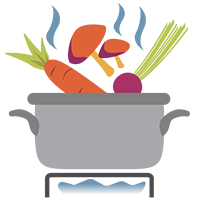Captivating Caramel Cream Cheese Drizzle

Captivating Caramel Cream Cheese Drizzle
Cream cheese frosting is a popular topping for cakes, especially carrot cake. It adds a tangy sweetness to desserts. With this recipe, we add Creamy Caramel Sauce to make a drizzle that elevates a cake from yummy to wow! Try it on our Blissful Banana Mug Cake!
Happy & Healthy Cooking,
Fun-Da-Mentals Kitchen Skills
- drizzle :
to trickle a thin stream of a liquid ingredient, like icing or sauce, over food.
- measure :
to calculate the specific amount of an ingredient required using a measuring tool (like measuring cups or spoons).
- whisk :
to beat or stir ingredients vigorously with a fork or whisk to mix, blend, or incorporate air.
Equipment Checklist
- Small bowl
- Measuring spoons
- Small whisk
Ingredients
Captivating Caramel Cream Cheese Drizzle
- 1 T cream cheese **(for DAIRY ALLERGY sub dairy-free/nut-free plain yogurt)**
- 1 T Creamy Caramel Sauce **(see caramel sauce recipe for food allergen substitutions)**
Food Allergen Substitutions
Captivating Caramel Cream Cheese Drizzle
- Dairy: Substitute dairy-free/nut-free plain yogurt for cream cheese. See Creamy Caramel Sauce recipe for food allergen substitutions
Instructions
Captivating Caramel Cream Cheese Drizzle
measure + whisk + drizzle
Measure and add 1 tablespoon cream cheese and 1 tablespoon Creamy Caramel Sauce to a small bowl and whisk well, until there are no lumps. Drizzle over a mug cake, like Blissful Banana Mug Cake.

Hi! I'm Cream Cheese!
"I'm a soft, mildly tangy, creamy white cheese. I'm not mature like some cheeses. I'm best fresh and new. I'm similar to mascarpone, an Italian soft cheese. I'm sweetest when I'm in cheesecake or cream cheese frosting!"
- Cream cheese is made from milk and cream. According to the United States Food and Drug Administration, cream cheese should have at least 33 percent milk fat and a maximum moisture content of 55 percent. It gets its slight tang from lactic acid. Lactic acid bacteria are added to pasteurized and homogenized milk. As a result, the pH level decreases as acid increases. The pH level of cream cheese should be between 4.4 to 4.9.
- Cream cheese was created in 1872 by William Lawrence, a dairy farmer in New York. While making Neufchâtel, a French cheese, he added too much cream and produced a softer, smoother cheese, giving it the generic name "cream cheese." It was renamed and marketed as "Philadelphia Cream Cheese" in 1880 to associate it with the high-quality dairy products from the Philadelphia, Pennsylvania area.
- Commercially-produced cream cheese includes salt, cheese culture, and a stabilizer like guar gum, carob bean gum, or xanthum gum. Cream cheese can also be made at home.
- Reduced-fat versions of cream cheese are available, which should have 16.5 to 20 percent milk fat. Whipped cream cheese is a more spreadable cream cheese.
- Cream cheese is a popular bagel spread, often called a "schmear," especially in New York City bagel shops. Additional toppings may include lox (brined and smoked salmon) and capers.
- Cream cheese may be added to dips, frostings, sauces, mashed potatoes, soup, pastry and pie fillings, omelets, and pasta dishes. It is sometimes blended with added garlic and herbs, like chives or parsley, or flavored with fruit, like strawberries or blueberries.
- One ounce or 2 tablespoons of full-fat cream cheese has approximately 99 calories with 10 grams of fat, 6 grams of saturated fat, and 90 milligrams of sodium.
- Cream cheese has about 2 grams of protein, 28 milligrams of calcium, and 38 milligrams of potassium. It has 10 percent of the daily value of vitamin A and 5 percent of the daily value of vitamin B2 or riboflavin.
- Cream cheese is low in lactose (milk sugar) at 2 grams per ounce and may be tolerated better than other dairy products for those with lactose intolerance.
History of Icing and Frosting!

- Icing has been used to cover cakes since the 17th century. One of the first icings was made of eggs, rosewater, and sugar. After the cake was covered, it was put back in the oven to harden the icing.
- The terms icing and frosting are sometimes interchangeable; however, many experts differentiate between icing and frosting, with icing being thinner and pourable and frosting thicker, creamier, and fluffier. Frosting can be spread with a spatula or piped with a pastry bag.
- A basic icing is a glaze made of powdered sugar and a liquid, like milk, water, or lemon juice. It is poured on cakes, cookies, or pastries or used to decorate them, as with royal icing.
- A frosting's base may be butter, cream, cream cheese, eggs, or whipped cream. Buttercream frosting is one of the most popular coverings and fillings for cakes. There are seven varieties of buttercream: American, French, German, Italian, Korean, Russian, and Swiss. The most common, American, Swiss, and Italian, are described below.
- American buttercream is the easiest to make and good for beginners or when there is a short amount of time. It is made by whipping softened butter, powdered sugar, milk or cream, and vanilla extract or other flavorings until smooth and fluffy. Additional milk or cream is added to adjust the consistency. It is the sweetest buttercream and the one most commonly used for piping decorations on a cake.
- Swiss buttercream uses a meringue and is appropriate for intermediate bakers. Professional pastry chefs often use it. To make Swiss meringue, egg whites and sugar are heated together over a double boiler. Then, butter and flavorings are added while the meringue is beaten. The result is a soft, silky frosting.
- Italian buttercream is also made with a meringue and is suitable for more advanced bakers. This version starts with making an Italian meringue by adding a stream of hot sugar syrup to the egg whites while they are whipped, resulting in a light and stable frosting.




